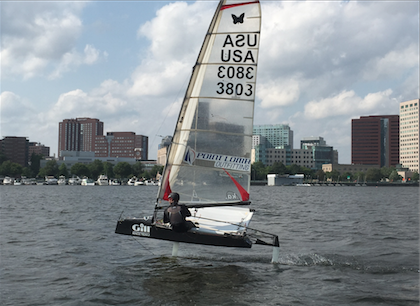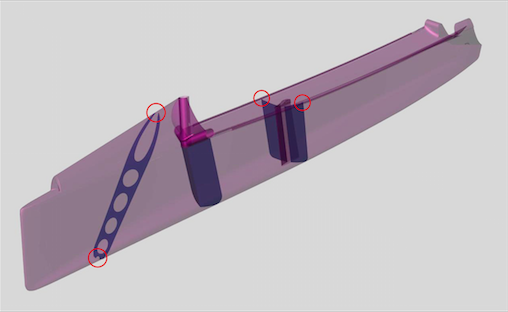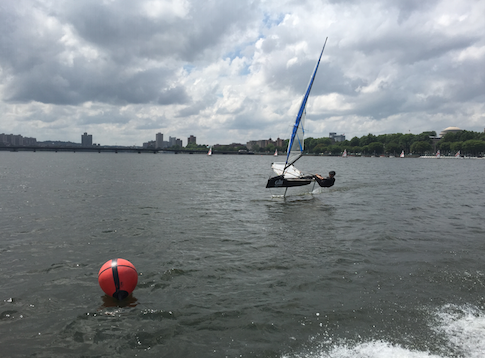Foiling Moth
From MITNA
The MIT Sailing Pavilion has a Foiling Moth that uses wing-like foils to lift the hull out of the water. This 11 foot, 65 pound dinghy "flies" above the water is only sailed by the most advanced sailors. Learning to sail the moth means spending a lot of time swimming since the boat does not stay upright in the water on its own. The boat is very fragile if used improperly and may result in injury if the sailor is not alert.
Contents
[hide]Requirements to Sail
- Must have full membership (Normal Sailing Card)
- Must have Helmsman rating
- Must have permission from Sailing Master Fran Charles or Varsity Sailing Coach Matt Lindblad
- Must have rating assigned by Fran Charles, Matt Lindblad, Mike Kalin, or Stew Craig
- Moth: Basic
- Buddy system: Must sail with moth-qualified buddy that is also motorboat capable
- Recommendation - on breezier days, 3 people buddy systems are more ideal
- Moth: Advanced
- May choose to sail moth without chase boat
- Moth: Basic
Safety For You (& The Boat)
- Don’t hang on to the tiller extension if you lose control or crash - it snaps over the wing easily.
- Do hold on the main sheet in a crash, if reasonable - the boat can easily sail 100 feet on its own (sometimes still foiling).
- Think of an exit strategy for any potential crash (especially if it’s windy). Try to get yourself clear of the boat so that you don’t hurt yourself or the boat.
- Don’t step on the hull, except the chine (corner).
- Do step on the centerboard (right next to the hull) to right the boat after a capsize - it’s much stronger than the hull.
- Watch out for the trailing (back edges) of the foils, and the ends - they are sharp.
- Watch out for the wand if swimming around the bow - it’s difficult to see in the water, pretty long, and very fragile.
- Watch out for falling off the wing through the sail (it has torn before), try to let yourself down carefully.
- Be extra mindful of traffic - that can be the scariest part when you’re first getting up. Purposefully crashing to windward and using your body to slow down can be an effective stopping method sometimes.
- Be extra mindful of being smooth with the tiller, especially as you move your body around the boat. Since the boat goes so fast and the rudder is long, the rudder cassette and pin get very loaded up when there are erratic rudder movements. These sort of movements also can make you crash…
Rigging the Foiling Moth
Rough sequence:
- Make sure the line going across the back from wingbar to wingbar is very tight. This keeps load off of the wingbar joints.
- Rig up sail (CST mast with red KA10, Mach2 mast with blue or black KA16)
- Check that the battens are snug (use a metric allen key from shop to adjust tensioners)
- put together mast, slide into luff pocket, put on cambers
- KA Sail Rigging Video
- move sail on top of boat, attach spreaders/shrouds
- Make sure the shrouds and forestay are properly seated in the ends of the “star” spreaders. Also make sure the shaft collars are set so that the star is roughly horizontal and symmetric port/stbd.
- pull up rig, place onto mast step, then tighten forestay pretty tight and tie off
- attach cunningham
- rig up boom (attach gooseneck first, make sure outhaul not tangled with downhaul)
- make sure vang all the way loose, attach clew of sail to boom and then attach outhaul
- flip boat over on its side -- orient so that you can tip it over foils first into the water with the boat pointed upwind
- can either get someone to help lift, or flip boat over with trolley and then carefully lift trolley off
- insert main foil, put in pin (center hole)
- Double check the pin and ring for the main foil, and make sure the bolt on the barrel adjuster is not bent. Side note -- DO NOT STEP ON THE BARREL ADJUSTER.
- rig up the rudder
- Make sure the tiller is lead through the bungee. This keeps the tiller centered if you let go, and also makes it harder to move the tiller too erratically.
- Put electrical tape over the breather holes. There is one on the stbd side of the transom, and one on the vertical section of the cockpit near the mast step. (Open these back up when you return to the dock)
- The holes should be reopened to let the pressure equalize once the boat has been in the water for a few minutes. This can easily be done on the dock or while the boat is capsized to port.
- untie wand keeper, then screw in wand linkage to the top of the main vertical. This should be the last thing you do when putting the boat in the water and the first thing you do when the boat comes out of the water to prevent people on the dock from tripping over and damaging the wand.
- A good rule of thumb for setting up the main foil ride height is that the horizontal flap should have a slight negative angle of attack when the wand is fully extended. This is ~5-7mm of pushrod showing
- Slide then tip the boat into the water, being careful of the wand and linkages. Try to lift the boat when tipping it upright instead of rotating it about the wingbar on the dock.
Derigging Notes
- The pin that holds the star spreader to the mast stays with the spreader because we have two different masts.
- The rudder pin stays in the rudder to prevent the rotating white plastic piece from spinning.
- Make sure you remove the tape from the breather holes.
- Drain the boat! If there is any water in the boat it is your responsibility to drain it fully.
- If you need to drain, derig first, then flip it upside down and lift the bow up so it drains out the back. Every once in a while put the bow back down to let air in
- Please initial that you drained boat on sign-out sheet, or note any other issues.
- http://www.mach2boats.com/the-mach2/service-and-maintenance
- The Mach 2 has small drain holes in each bulkhead. These little holes allow water to flow through the boat so it can be emptied via the bung holes in each tank. This image should make it easier for Mach 2 sailors to empty any water that may get into the boat. Note: The red circles are the drain holes
Sailing Basics
- Stay on your feet! When not up foiling and hiking, try keeping your feet underneath you; half crouching/sitting is good as you’ll have to adjust your weight a lot as you get the balance of the boat at low speed.
- To get foiling, sail on a reach. A pretty tight reach is usually best but once there is a lot of breeze there is a wide range of angles that will work. Give the main a nice ease, and once the boat starts to heel to windward, bear off a bit and let the boat power up. Once it starts to pop up onto the foils and accelerate, you will need to trim in the mainsheet a good amount because the apparent wind starts to move forward.
- Keep the rig on top of you! Like a windsurfer. Always have windward heel - if you get too flat, or heeled to leeward, ease the main until the boat comes back on top of you. Hiking helps too, but the rig can generate a lot of power so the mainsheet is most important.
- Control the power! Easing and trimming to power up and depower is important of course, but steering in and out of your power zones is super important too.
- Upwind: pinch to depower, foot to power up.
- Downwind: sail to a run to depower, up to a reach to power up.
- Be active in the straps! It can be necessary to move in through a lull or if you stall the sail.
- Sit forward! Further than you might think - just behind where the wing starts to curve (just behind the control lines on the trampoline).
- Observe! Often taking a break and watching someone else sail for a while can have a huge impact when you go back in.
- The moth class has made some basic tutorials with Nathan Outteridge https://www.youtube.com/playlist?list=PLCFOdEqGeu5CYFzz51JhpQ4ubz6qHiQs7
Tuning Basics
- Vang is good - it is especially hard to see from on the boat, so use it. And then use more. And probably even more.
- Cunningham depowers the sail significantly.
- Keep a moderate amount of cunningham on at all times so that the camber inducers in the sail remain on the mast. This is maybe a bit more than finger tight?
- If the cambers do come off while sailing, you can sail a little bit if needed but it’s best to fix it ASAP so that the sail doesn’t get damaged. This can be done back at the dock or with help from the motorboat, or swimming with the boat capsized with a bit more effort.
- Outhaul - loose until it gets breezy.
- Ride height adjuster (the little barrel in the middle of the deck) - try to forget it when you’re starting out. Controls the equilibrium height of “flight.” Higher is faster, but there’s a risk of going too high and losing control. A note on the current setup, up is down and down is up on the deck markings.
- The Mach2 likes to sail a little “bow-down” (partially due to hydrodynamics with the fixed part of the main horizontal, partially due to aero drag on the wings). With our foil setup this usually means the first indication you are riding too high is ventilation on the rudder horizontal. Upwind this is on the leeward tip since you are heeling far to windward, and downwind the first warnings are often just some funny noises or occasional brief loss of steering.
- Upwind you will want to adjust the ride height slightly from tack to tack (the wand is asymmetrical so it “measures” the boat’s height differently on each side due to the extreme windward heel when sailing upwind)
- Wand is on stbd side, so the boat “thinks” its riding lower than it actually is on that tack. Adjust the ride height lower to compensate. Adjust ride height higher on port.
- Approx 2 rotations of the barrel adjuster is a rough range, but you should play around with it so that the boat is about the same height on each tack (look down at the marks on the daggerboard vertical)
- Usually the stbd side (lower) adjustment is about right for going downwind
- Wand is on stbd side, so the boat “thinks” its riding lower than it actually is on that tack. Adjust the ride height lower to compensate. Adjust ride height higher on port.
- Rudder lift - control how bow up or down the boat rides by twisting the tiller extension. Bow-down/more rudder lift when going upwind (bolt head forward ~ ¼ from front), and bow-up/less rudder lift when going downwind (going faster produces more lift from the rudder, and a slightly bow-up pitch is safer as well) (bolt head back ~ ½ - ¾ from front). Try not to worry about it when you’re just starting, but be mindful that it can get out of position easily if you’re spending a lot of time crawling in and out of the boat.
- If boat kind of pops up quickly and then stalls (often in marginal foiling breeze), this most likely means there isn’t enough rudder lift. Twist the rudder so the bolt moves forward in the slot.
- Occasionally check that the ride height adjuster is wound correctly and not tangled



